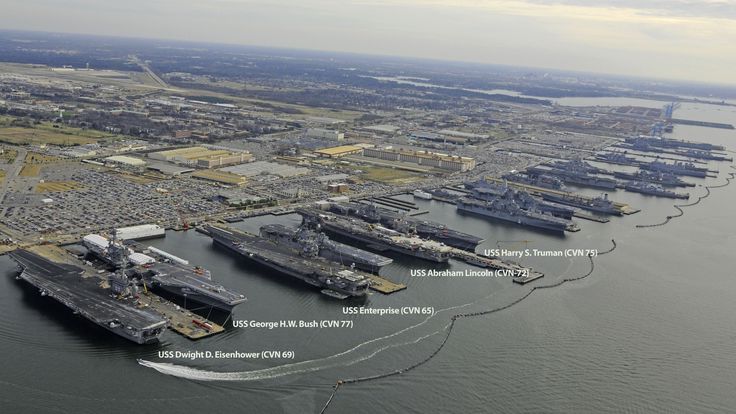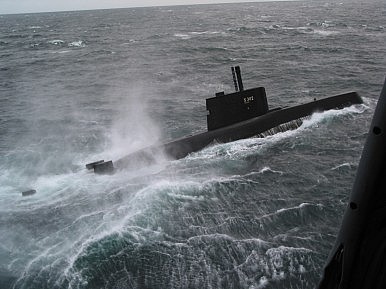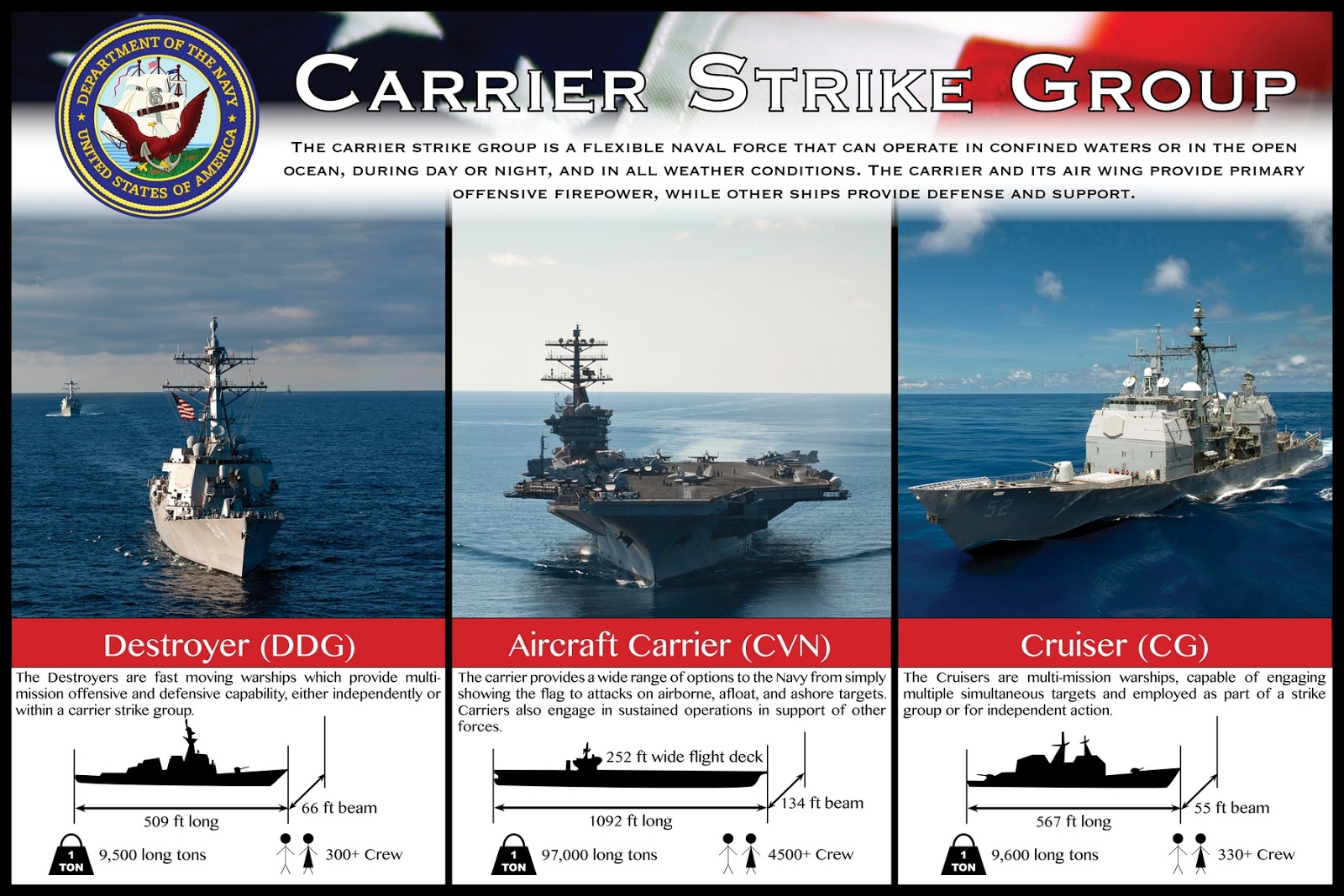How to install the app on iOS
Follow along with the video below to see how to install our site as a web app on your home screen.
Note: This feature may not be available in some browsers.
You are using an out of date browser. It may not display this or other websites correctly.
You should upgrade or use an alternative browser.
You should upgrade or use an alternative browser.
US military news, discussions and history
- Thread starter SvenSvensonov
- Start date
mike2000 is back
ELITE MEMBER

- Joined
- Apr 12, 2015
- Messages
- 8,513
- Reaction score
- 19
- Country
- Location
This is why the U.S is by far the most formidable Naval force in the World.


Here's a rare sight: four out of the ten Nimitz-class aircraft carriers—the largest warships ever built—plus an Enterprise-class carrier docked together. They are resting at Naval Station Norfolk, Virginia, which coincidentally is the largest naval base in the world. Look at all that engineering and firepower. And it's only half of the Nimitz fleet!




Battleship salvo fire. Now there's your BIG BANG! A salvo from the U.S.S Iowa’s 16 inch and 5 inch guns would displace around 100,000 tons of water and move the ship sideways approximately 9 feet
A salvo from the U.S.S Iowa’s 16 inch and 5 inch guns would displace around 100,000 tons of water and move the ship sideways approximately 9 feet


Here's a rare sight: four out of the ten Nimitz-class aircraft carriers—the largest warships ever built—plus an Enterprise-class carrier docked together. They are resting at Naval Station Norfolk, Virginia, which coincidentally is the largest naval base in the world. Look at all that engineering and firepower. And it's only half of the Nimitz fleet!



Battleship salvo fire. Now there's your BIG BANG!
 A salvo from the U.S.S Iowa’s 16 inch and 5 inch guns would displace around 100,000 tons of water and move the ship sideways approximately 9 feet
A salvo from the U.S.S Iowa’s 16 inch and 5 inch guns would displace around 100,000 tons of water and move the ship sideways approximately 9 feetAzeri440
SENIOR MEMBER

- Joined
- Sep 29, 2012
- Messages
- 3,304
- Reaction score
- 5
- Country
- Location
bidonv
FULL MEMBER

- Joined
- Dec 11, 2015
- Messages
- 164
- Reaction score
- 0
- Country
- Location
By:thediplomat.com
Why the US Needs Conventional Submarines

The Norwegian ULA class submarine Utstein (KNM 302) participates in NATO exercise Odin-One.
Why the US Needs Conventional Submarines
The U.S. Armed Forces operate a wide array of sophisticated weaponry, in many cases superior to anything else in the world. But while the new destroyers, carriers, or the F-22 might have no equal, the U.S. Armed Forces face a significant gap in their capabilities: the total lack of any conventional submarines.
The United States hasn’t produced any conventional submarines since the Barbel-class in the late 1950s; every submarine class since then has been nuclear powered. This might have made sense in the context of the Cold War, where Soviet nuclear-powered ballistic missile submarines had to be shadowed, but times have changed.
While previously conventional submarines had to snorkel roughly at least every two days of time under water to recharge their batteries, air-independent propulsion (AIP) has changed the game. German Type 212 submarines can stay under water without snorkeling for up to three weeks, traveling 1,500 miles (2,400 kilometers) or more. Without emitting heat and with no need for constant cooling due to the lack of a nuclear reactor, these German submarines and comparable designs are more than a match for nuclear-powered submarines in terms of stealthiness.
Whereas the Soviet Union had submarines cruising the globe’s waters, the next big naval challenge for the United States isn’t a revitalized Russian navy, but the People’s Liberation Army Navy’s subs and ships lurking in the South China Sea and East China Sea. These submarines could play a key role in trying to enforce China’s A2/AD (anti-access/area denial) strategy against a superior USN, with the goal of preventing the United States from intervening in any conflict involving the Spratly Islands, the Paracel Islands, the Senkaku Islands, and Taiwan.
With the PLAN’s mostly conventional submarine force, the USN’s superior anti-submarine warfare capabilities will continue to severely hinder any Chinese submarine operations outside the first island chain and outside of China’s land-based air cover. This limits the theater of operations to a high degree and puts it well into range for conventional submarines using only their AIP based in Okinawa, Singapore, Subic Bay, Guam, or possibly Zuoying Naval Base on Taiwan.
Whereas China can and will create a bigger subsurface fleet than the USN by mixing conventional submarines with nuclear powered ones, the financial burden of matching hull with hull is practically impossible for the United States, at least as long as it limits the USN to SSNs. Conventional submarines might change this.
While one Virginia-class submarine costs roughly $2.7 billion per unit, the same money could buy six to seven conventional submarines of the German Type 212 class. While U.S. nuclear-attack submarines are superb, many examples have shown that sophisticated conventional submarines aren’t just a match for surface fleets but also for older SSNs under the right circumstances.
In case of a conflict with China, the majority of naval combat will happen well within the first island chain, where a purely nuclear-powered fleet seems like a waste of assets. Neither their range nor their speed will be needed in most cases. As conventional submarines will be able to handle most tasks, the dramatically more expensive SSNs could stay out of the first island chain concentration on shadowing the PLAN’s SSBNs and SSNs outside this area, while keeping enough in reserve and out of harm’s way to maintain a credible deterrence against Russia at the same time. Additional conventional subs would also prevent the projected sub shortfall starting in 2021.
But going back into the business of building conventional submarines for the USN wouldn’t just make sense from an fiscal point of view for a navy that has limited resources. It would also offer various economic and political options for the United States.
President George W. Bush promised Taiwan eight conventional subs in 2001, which were never delivered. If the United States were to start building conventional submarines again, the pledge to Taiwan could finally be fulfilled. Moreover, the market for conventional submarines is gigantic. Most Asian nations are looking to establish, increase, or modernize their submarine fleets; Germany and France have both enjoyed particular success marketing their submarines to countries like South Korea, Indonesia, India, and Malaysia. Many of these nations are close U.S. allies or friends. The market for modern conventional submarines built in the United States would probably amount to several dozen hulls within the next two decades.
Built in the U.S., employing U.S. workers, and spreading the development costs over ever more hulls, Washington could seriously consider subsidizing some of those submarines for navies which are direly in need for a naval deterrence against an ever more aggressive China. If the United States doesn’t want to hand Asia over to China on China’s terms, a price might have to be paid in the end. It’ll be either money or blood. Subsidized submarines for the Philippines and Taiwan might just be what it takes to show the steadfast commitment for the status quo and the support for those two nations, which are under heavy pressure from the Middle Kingdom.
Conventional submarines with AIP wouldn’t just bolster the USN’s capabilities in this crucial theater for a comparative bargain, they would also allow the U.S. to enter a sizable weapons....................Read more

The Norwegian ULA class submarine Utstein (KNM 302) participates in NATO exercise Odin-One.
monitor
ELITE MEMBER

- Joined
- Apr 24, 2007
- Messages
- 8,570
- Reaction score
- 7
- Country
- Location
House Lawmakers Want Air Force To Consider Buying More B-21 Bombers
 Lara Seligman, Defense News 10:12 a.m. EDT April 20, 2016
Lara Seligman, Defense News 10:12 a.m. EDT April 20, 2016

(Photo: US Air Force)
172 CONNECTTWEET 115 LINKEDIN 2 COMMENTEMAILMORE
WASHINGTON — As advocates call on the Pentagon to buy as many as 200 next-generation bombers to counter growing threats, House legislation released this week urged the Air Force to take another look at how many B-21s commanders really need.
Both top military officials and experts outside the Pentagon have recommended the Air Force buy more than the 100 planned Northrop Grumman B-21 bombers to ensure enough aircraft are available to meet combatant commander requirements, according to the House Armed Services Seapower and Projection Forces Subcommittee’s markup of the 2017 defense policy bill, released Tuesday.
The sweet spot is between 174 and 205 B-21s, independent experts told the committee, according to the legislation. Meanwhile, Air Force Global Strike Commander Gen. Robin Rand said the 100-bomber number should be treated as the lower limit of the requirement, lawmakers noted.

DEFENSE NEWS
Advocates Call For 200 Next-Generation Bombers

DEFENSE NEWS
USAF Wants To Buy 100 Long Range Strike-Bombers
The legislation would direct the secretary of the Air Force to submit a report to the congressional defense committees by Feb. 1, 2017, estimating the number of B-21s needed to meet the demand signal. The report should also include a detailed transition plan that integrates the B-21 into the current bomber fleet out to 2040, according to the language.
Lawmakers also expressed concern that Congress does not have sufficient ability to track cost and schedule of the highly classified development effort. The legislation would direct the secretary to submit an initial “B-21 Development Progress Matrix” to the congressional defense committees, including milestones and metrics for measuring the program’s progress.
“The committee is pleased to see progress on this program and believes that this program has stable requirements in place,” according to the legislation. “However, the committee is concerned that, given the length of time associated with the [engineering, manufacturing and development] phase and the amount of resources planned for this phase, the congressional defense committees need an improved ability to track annual progress and cost throughout the development.”
The legislation comes on the heels of a recent Congressional Research Service report urging Congress to take a look at whether it has enough oversight of the bomber program. The Pentagon is procuring the B-21 via the Air Force’s secretive Rapid Capabilities Office, a small group inside Air Force acquisitions that handles classified programs such as the X-37B spacecraft. The RCO is exempt from many of the rules and regulations Congress usually imposes on a normal acquisition program.
Congress must determine whether the advantages gained through using the secretive RCO outweigh the challenges of adequately overseeing a highly classified program, according to the CRS report.

DEFENSE NEWS
Does Congress Have Enough Oversight of the B-21?
Email: [email protected]
Twitter: @laraseligman
 Lara Seligman, Defense News 10:12 a.m. EDT April 20, 2016
Lara Seligman, Defense News 10:12 a.m. EDT April 20, 2016
(Photo: US Air Force)
172 CONNECTTWEET 115 LINKEDIN 2 COMMENTEMAILMORE
WASHINGTON — As advocates call on the Pentagon to buy as many as 200 next-generation bombers to counter growing threats, House legislation released this week urged the Air Force to take another look at how many B-21s commanders really need.
Both top military officials and experts outside the Pentagon have recommended the Air Force buy more than the 100 planned Northrop Grumman B-21 bombers to ensure enough aircraft are available to meet combatant commander requirements, according to the House Armed Services Seapower and Projection Forces Subcommittee’s markup of the 2017 defense policy bill, released Tuesday.
The sweet spot is between 174 and 205 B-21s, independent experts told the committee, according to the legislation. Meanwhile, Air Force Global Strike Commander Gen. Robin Rand said the 100-bomber number should be treated as the lower limit of the requirement, lawmakers noted.

DEFENSE NEWS
Advocates Call For 200 Next-Generation Bombers

DEFENSE NEWS
USAF Wants To Buy 100 Long Range Strike-Bombers
The legislation would direct the secretary of the Air Force to submit a report to the congressional defense committees by Feb. 1, 2017, estimating the number of B-21s needed to meet the demand signal. The report should also include a detailed transition plan that integrates the B-21 into the current bomber fleet out to 2040, according to the language.
Lawmakers also expressed concern that Congress does not have sufficient ability to track cost and schedule of the highly classified development effort. The legislation would direct the secretary to submit an initial “B-21 Development Progress Matrix” to the congressional defense committees, including milestones and metrics for measuring the program’s progress.
“The committee is pleased to see progress on this program and believes that this program has stable requirements in place,” according to the legislation. “However, the committee is concerned that, given the length of time associated with the [engineering, manufacturing and development] phase and the amount of resources planned for this phase, the congressional defense committees need an improved ability to track annual progress and cost throughout the development.”
The legislation comes on the heels of a recent Congressional Research Service report urging Congress to take a look at whether it has enough oversight of the bomber program. The Pentagon is procuring the B-21 via the Air Force’s secretive Rapid Capabilities Office, a small group inside Air Force acquisitions that handles classified programs such as the X-37B spacecraft. The RCO is exempt from many of the rules and regulations Congress usually imposes on a normal acquisition program.
Congress must determine whether the advantages gained through using the secretive RCO outweigh the challenges of adequately overseeing a highly classified program, according to the CRS report.

DEFENSE NEWS
Does Congress Have Enough Oversight of the B-21?
Email: [email protected]
Twitter: @laraseligman
bidonv
FULL MEMBER

- Joined
- Dec 11, 2015
- Messages
- 164
- Reaction score
- 0
- Country
- Location
By:abcnews.go.com
Trailblazer Becomes Army's First Female Infantry Officer

Capt. Kristen Griest waits at Lawson Airfield for the Airborne Assault exercise to begin during U.S. Army's Ranger School at Fort Benning, Ga., April 25, 2015.
Trailblazer Becomes Army's First Female Infantry Officer
Already a trailblazer, Army Captain Kristen Griest became the Army’s first female infantry officer when, on Monday, the Army approved her request to transfer from the military police unit she had been serving in.
Griest became well-known last year after she became one of the first three women to successfully complete the Army's elite Ranger School course.
“Like any other officer, male or female, that wants to transfer their branch, she took the opportunity and applied for an exception to the Army policy to transfer her branch from Military Police to Infantry,” said Bob Purtiman, a spokesman at Fort Benning, Georgia. Purtiman confirmed to ABC News that Griest's transfer request was approved by the Army on Monday and she became immediately eligible to serve in an Army infantry unit.
After successfully completing Ranger School last year, Griest returned to service at her home base at Fort Campbell, Kentucky. The participation of women in the Ranger School course was part of the Army's research into whether women should be integrated into combat units. The other military services also conducted similar programs that were presented to Defense Secretary Ash Carter last fall. .....................See more

Capt. Kristen Griest waits at Lawson Airfield for the Airborne Assault exercise to begin during U.S. Army's Ranger School at Fort Benning, Ga., April 25, 2015.
bidonv
FULL MEMBER

- Joined
- Dec 11, 2015
- Messages
- 164
- Reaction score
- 0
- Country
- Location
By:www.defenseworld.net
DARPA Awards Research Contract For Future Armored Vehicles
DARPA Awards Research Contract For Future Armored Vehicles
Future Armored vehicles will be able to deflect incoming threats by moving their armor plates up, down or sideways, be light, agile and have greater situational awareness than the steel behemoths of today.
The US Defence Advance Research projects agency has awarded contracts to Carnegie Mellon University, Honeywell, Leidos, Pratt & Miller, QinetiQ Inc., Raytheon, Southwest Research Institute and SRI International.
“We’re exploring a variety of technologies, all of which are designed to improve vehicle mobility, vehicle survivability and crew safety and performance without piling on armor,” said Maj. Christopher Orlowski, DARPA program manager.
GXV-T is pursuing research in the following four technical areas, Radically Enhanced Mobility—Ability to traverse diverse off-road terrain, including slopes and various elevations. Capabilities of interest include revolutionary wheel/track and suspension technologies that would enable greater terrain access and faster travel both on- and off-road compared to existing ground vehicles.
Survivability through Agility—Autonomously avoid incoming threats without harming occupants through technologies that enable, for example, agile motion and active repositioning of armor. Capabilities of interest include vertical and horizontal movement of armor to defeat incoming threats in real time.
Crew Augmentation—Improved physical and electronically assisted situational awareness for crew and passengers; semi-autonomous driver assistance and automation of key crew functions similar to capabilities found in modern commercial airplane cockpits. Capabilities of interest include high-resolution, 360-degree visualization of data from multiple onboard sensors and technologies to support closed-cockpit vehicle operations.
Signature Management—Reduction of detectable signatures, including visible, infrared (IR), acoustic and electromagnetic (EM).
Capabilities of interest include improved ways to avoid detection and engagement by adversaries...................See more

bidonv
FULL MEMBER

- Joined
- Dec 11, 2015
- Messages
- 164
- Reaction score
- 0
- Country
- Location
By:www.naval-technology.com
USS Montogomery completes acceptance trials of US Navy

USS Montogomery completes acceptance trials of US Navy
The Austal-built eighth Independence-variant Littoral combat ship (LCS 8), USS Montgomery, has completed acceptance trials conducted by the US Navy.
The four-day trial involved comprehensive testing of the vessel's major systems and equipment by the US Navy, including
of the propulsion plant, ship handling, and auxiliary systems.
The vessel also conducted launch and recovery operations of the 11m rigid hull inflatable boat (RHIB), and undertook a full power run for a duration of four hours.
"The successful completion of acceptance trials is a significant milestone for Austal and demonstrates how the LCS programme is progressively maturing."
USS Montgomery also took part in surface and air self-defence detect-to-engage exercises, and exhibited the ship's maneuverability by performing tight turns and achieving speeds of more than 40k.
Austal CEO David Singleton said: "The successful completion of acceptance trials is a significant milestone for Austal and demonstrates how the LCS programme is progressively maturing.
"LCS 8 incorporates most of the modifications that have been identified to date following delivery of LCS 6, our first as prime contractor."
The US Navy had earlier awarded a $3.5bn contract to construct and deliver ten more LCSs.................Read more

bidonv
FULL MEMBER

- Joined
- Dec 11, 2015
- Messages
- 164
- Reaction score
- 0
- Country
- Location
By:nationalinterest.org
The U.S. Navy's Dangerous Nuclear Attack Submarine Shortage

The U.S. Navy's Dangerous Nuclear Attack Submarine Shortage
The U.S. Navy hopes to continue to build two Virginia-class attack submarines per year while also building the Ohio Replacement Program ballistic missile submarine starting in 2021. But does the United States still have the industrial capacity to build more than two nuclear submarines at a time?
The increased build rate would help to alleviate a severe shortfall in the number of available attack submarines in the Navy’s inventory—which is set to drip to 41 boats by 2029. But moreover, with the growing threat from a resurgent Russia and an increasingly hostile China, the service is recalibrating its stated requirement for 48 attack submarines.
It has become clear that the service needs more than 48 attack submarines. Even with 52 boats currently in service—four more than the stated requirement—the Navy is not able to meet the worldwide demand for submarine capability. “We have a compelling need for additional attack submarines,” Sean Stackley, assistant secretary of the Navy for research, development and acquisition told the Congress in late February. “Today, we have 52 boats, a requirement for 48, we have a valley of 41 boats in the 2030s, we start falling below the line in the late 2020s.”
The Navy is working on reducing the costs of the Ohio Replacement Program to pay for an additional Virginia-class boat when the new ballistic missile submarine enters production in 2021. “We’ve got to nail down what it’s going to cost to add a second Virginia in 2021 in POM 18.....................Read more

Similar threads
- Replies
- 0
- Views
- 89
- Replies
- 0
- Views
- 102
- Replies
- 0
- Views
- 312
- Replies
- 0
- Views
- 101

























